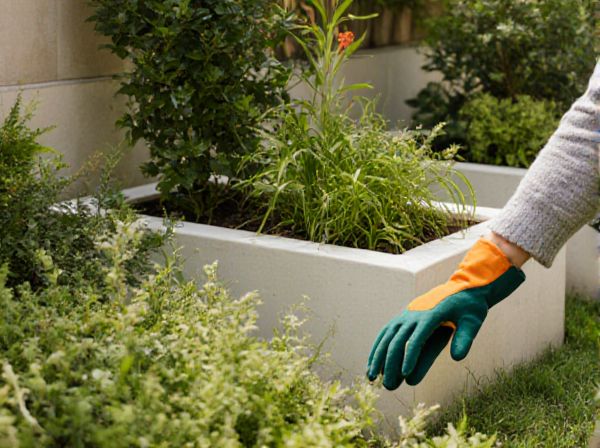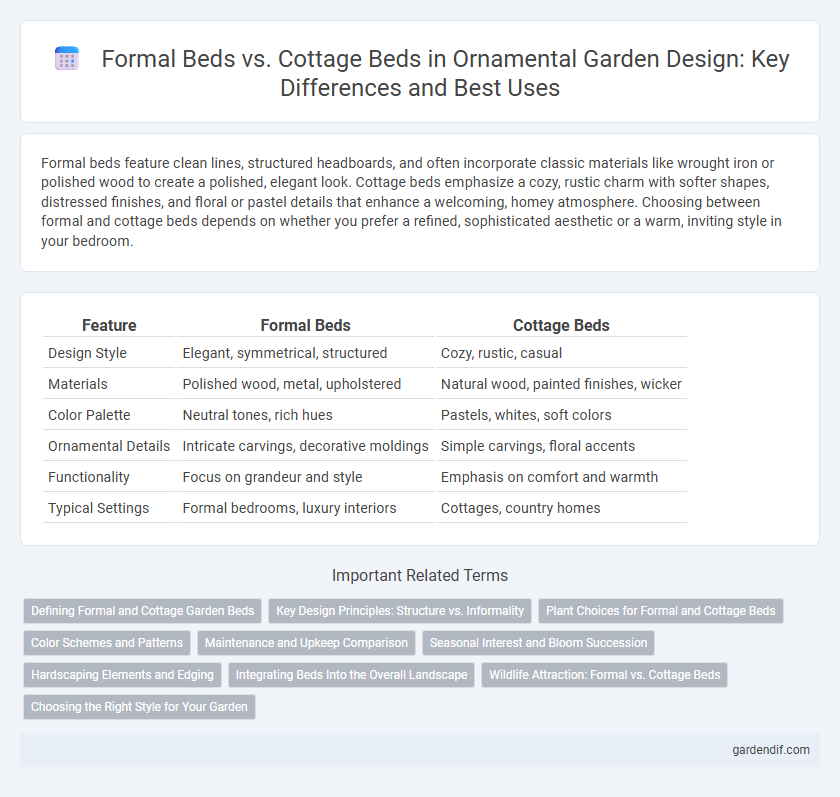
Formal Beds vs Cottage Beds Illustration
Formal beds feature clean lines, structured headboards, and often incorporate classic materials like wrought iron or polished wood to create a polished, elegant look. Cottage beds emphasize a cozy, rustic charm with softer shapes, distressed finishes, and floral or pastel details that enhance a welcoming, homey atmosphere. Choosing between formal and cottage beds depends on whether you prefer a refined, sophisticated aesthetic or a warm, inviting style in your bedroom.
Table of Comparison
| Feature | Formal Beds | Cottage Beds |
|---|---|---|
| Design Style | Elegant, symmetrical, structured | Cozy, rustic, casual |
| Materials | Polished wood, metal, upholstered | Natural wood, painted finishes, wicker |
| Color Palette | Neutral tones, rich hues | Pastels, whites, soft colors |
| Ornamental Details | Intricate carvings, decorative moldings | Simple carvings, floral accents |
| Functionality | Focus on grandeur and style | Emphasis on comfort and warmth |
| Typical Settings | Formal bedrooms, luxury interiors | Cottages, country homes |
Defining Formal and Cottage Garden Beds
Formal beds feature symmetrical layouts, geometric shapes, and neatly trimmed hedges that create a sense of order and precision, often incorporating boxwood borders and gravel paths. Cottage garden beds emphasize informal designs with densely planted perennials, climbing roses, and a mix of colors, textures, and heights, evoking a natural, whimsical atmosphere. Defining these beds hinges on their structure: formal beds prioritize balanced symmetry and restraint, while cottage beds celebrate abundance and a relaxed, charming aesthetic.
Key Design Principles: Structure vs. Informality
Formal beds emphasize structured design with symmetrical lines, polished finishes, and often incorporate classic materials like wrought iron or rich wood. Cottage beds showcase informality through rustic, distressed textures, soft curves, and a cozy, inviting aesthetic that favors comfort over precision. The key design principle differentiates formal beds' architectural rigidity from cottage beds' relaxed, charming imperfection.
Plant Choices for Formal and Cottage Beds
Formal beds typically feature symmetrical arrangements with structured plant choices such as boxwood, lavender, and topiary evergreens, providing a neat and polished appearance. Cottage beds emphasize informal, eclectic plant selections like foxgloves, hollyhocks, and delphiniums that create a relaxed, whimsical atmosphere. Both styles benefit from perennials and annuals chosen to complement their distinct design philosophies and enhance seasonal color.
Color Schemes and Patterns
Formal beds often feature rich, deep color schemes such as navy, burgundy, and emerald, accented with elegant patterns like damask or paisley that emphasize sophistication and luxury. Cottage beds typically showcase soft, pastel hues like pale blue, lavender, or cream, paired with floral or gingham patterns that evoke a cozy, charming ambiance. Both styles use their distinct color palettes and patterns to create specific moods, with formal beds leaning towards opulence and cottage beds toward rustic comfort.
Maintenance and Upkeep Comparison
Formal beds often require meticulous maintenance due to their elaborate frames and delicate fabrics, necessitating regular dusting and occasional professional cleaning to preserve their pristine appearance. Cottage beds, characterized by simpler designs and durable materials, generally demand less intensive upkeep, allowing for easier cleaning and greater resilience to wear. Both styles benefit from routine inspection of joints and finishes to ensure longevity and maintain aesthetic charm.
Seasonal Interest and Bloom Succession
Formal beds emphasize structured planting with seasonal interest achieved through carefully timed bloom succession of classic perennials like tulips, daffodils, and lavender, ensuring a polished and continuous display. Cottage beds favor a more relaxed, natural aesthetic, incorporating a diverse mix of flowering shrubs and herbaceous plants such as roses, foxgloves, and hollyhocks, which provide overlapping bloom periods and varied textures throughout the seasons. Strategic selection in both styles maximizes floral longevity and visual appeal, enhancing garden ornamentation year-round.
Hardscaping Elements and Edging
Formal beds often incorporate hardscaping elements such as stone or brick edging, creating clean lines and structured boundaries that emphasize symmetry and order. Cottage beds typically feature softer, natural edging materials like wood or low-growing plants, enhancing a more informal, rustic appearance that blends with surrounding vegetation. The choice of hardscaping and edging directly influences the overall aesthetic, defining the garden's style as either polished and geometric or relaxed and organic.
Integrating Beds Into the Overall Landscape
Formal beds emphasize symmetry, structured geometry, and defined borders, seamlessly integrating with classical landscape designs by reinforcing order and balance. Cottage beds feature informal shapes, diverse plantings, and naturalistic flows, blending effortlessly into casual, rustic garden settings that prioritize charm and spontaneity. Choosing between formal and cottage beds depends on the desired harmony between bed design and the overarching landscape aesthetic.
Wildlife Attraction: Formal vs. Cottage Beds
Formal beds with their structured, symmetrical design tend to attract pollinators such as bees and butterflies by showcasing uniform flower placement that provides easy access to nectar. Cottage beds create a more diverse habitat through a mix of plant heights, colors, and textures, drawing a wider range of wildlife including birds, beneficial insects, and small mammals. The diverse plant composition in cottage beds promotes ecological balance and supports local biodiversity more effectively than the strict arrangement of formal beds.
Choosing the Right Style for Your Garden
Formal beds emphasize symmetry, structured shapes, and often incorporate neatly trimmed hedges or topiary to create a refined, elegant atmosphere ideal for classical garden designs. Cottage beds favor a more relaxed, informal look with a diverse mix of flowering plants and herbs arranged in a seemingly spontaneous yet harmonious manner, perfect for creating cozy, whimsical garden spaces. Selecting between formal and cottage beds depends on the desired garden mood, maintenance level, and overall landscape architecture, balancing precision with natural charm.
Formal Beds vs Cottage Beds Infographic

 gardendif.com
gardendif.com